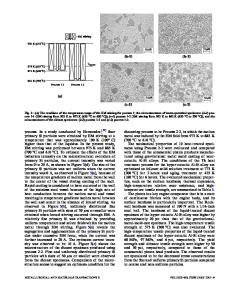Effects of Curing Temperature on the Mechanical Reliability of Low Dielectric-Constant Spin-on-Glasses
- PDF / 361,560 Bytes
- 6 Pages / 612 x 792 pts (letter) Page_size
- 23 Downloads / 294 Views
EFFECTS OF CURING TEMPERATURE ON THE MECHANICAL RELIABILITY OF LOW DIELECTRIC-CONSTANT SPIN-ON-GLASSES Yvete Toivola, Robert F. Cook and Chandan Saha 1 Department of Chemical Engineering and Materials Science University of Minnesota 421 Washington Avenue SE, Minneapolis, MN 55455 1 Dow Corning Corporation 2200 W. Salzburg Road, Midland, MI 48686 ABSTRACT The variations in the mechanical properties of a commercial low-k silsesquioxane material with curing temperature are examined, focusing on the transition from the low modulus, high stress, under-cured state to the high modulus, low stress, over-cured state. Film modulus and hardness are determined by instrumented nanoindentation and film dielectric constant is determined by ac capacitance measurements of metal dot structures. The mechanical behavior is correlated with changes in molecular structure via infrared spectroscopy. An implication of the results is that there is an intermediate curing temperature for optimum silsesquioxane interconnection performance.
INTRODUCTION Spin-on glass films, formed by the polymerization of silsesquioxane (SSQ) oligomers [1], have great potential as semiconductor interconnection materials due to their low dielectric-constants k = (2.5 – 3.3), tunable properties, compatibility with silica chemistry and extendibility to even lower dielectric constant [2] via increased porosity. The mechanical properties of SSQ materials, however, are inferior to those of silica, particularly the resistance to moisture-assisted, residual-stress driven stress-corrosion cracking, leading to interconnection yield and reliability concerns [3, 4]. In addition, the underlying mechanical properties controlling cracking – modulus, hardness, toughness and film stress – are extremely sensitive to the time, temperature and environment used during the polymerizing curing process [3-5]. Here we extend our previous work [3-6] characterizing the processing-properties linkage in SSQ materials to the structureproperties linkage. Infrared spectroscopy will be used to characterize the development of the polymerized three-dimensional -Si-O-Si- bridged network from the initial oligomeric non-bridging -Si-H terminated structure. EXPERIMENTAL Commercial low-k Hydrogen Silsesquioxane (HSSQ) solutions (FOx, Dow Corning Corporation, Midland, MI) were spin coated onto 150 mm diameter Si wafers to form films 0.5 and 1 µm thick. The films were cured for 1 hour in a N 2 environment at temperatures of 375, 400, 425 and 450 oC to yield bulk polymerization of the precursor
D5.4.1
oligomers and hard “spin-on-glass” films. Dielectric constants of the films increased with curing temperature over the range 2.5-3.1, similar to previous observations [3, 4]. RESULTS Infrared Spectroscopy
A b s o rb a n c e
Infrared spectroscopy was used to track chemical changes as a function of curing temperature. On curing, HSSQ films polymerize via a chemical reaction in which networking occurs via Si-O bridging. Quantitative information about changes in chemistry as a function of curing temperatur
Data Loading...











